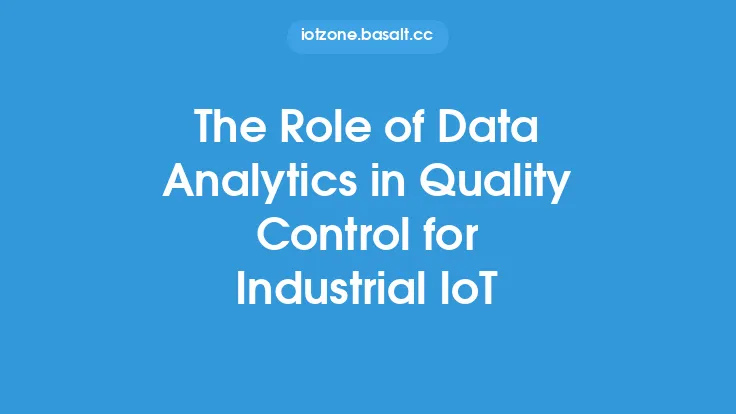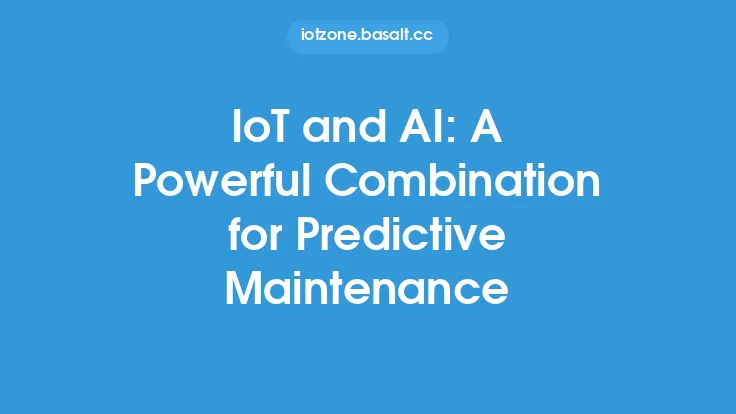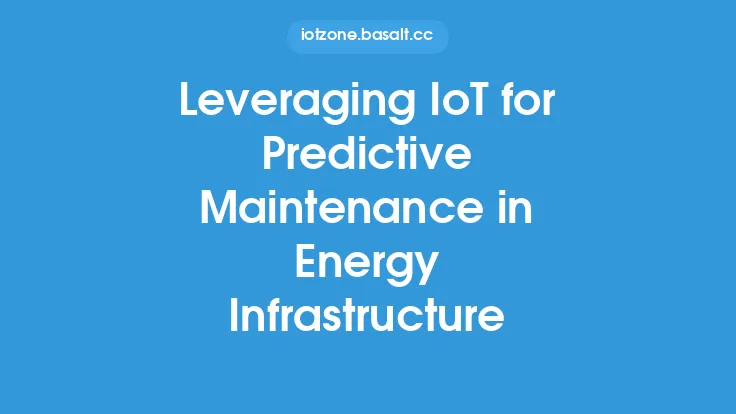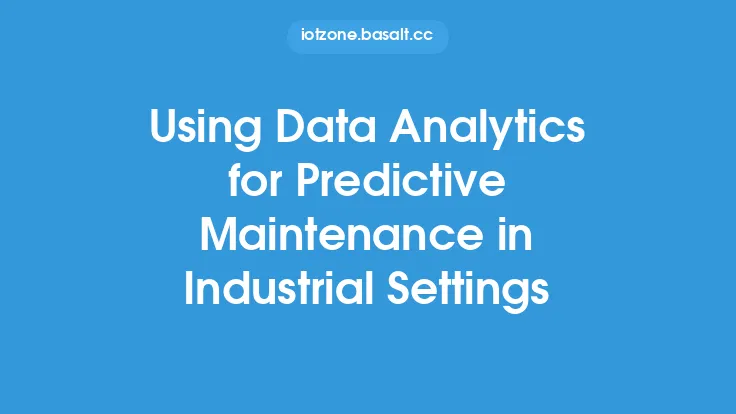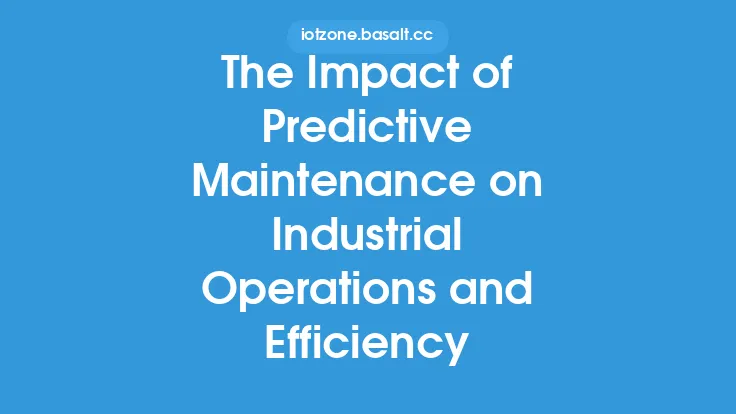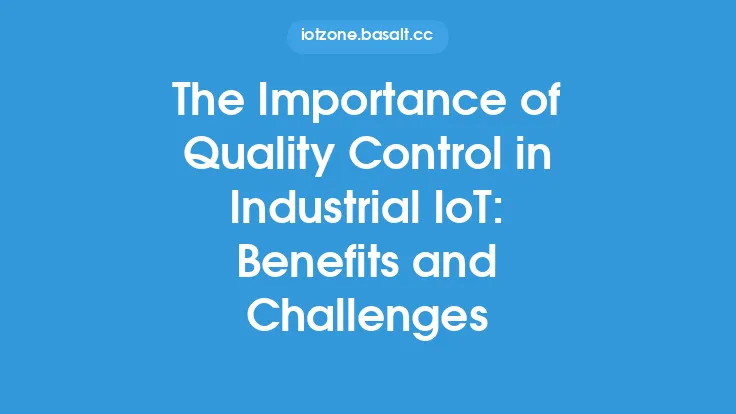The increasing use of Internet of Things (IoT) devices in various industries has led to a significant amount of data being generated. This data can be leveraged to improve maintenance and quality control processes, reducing downtime and increasing overall efficiency. Predictive maintenance and quality control are two areas where IoT data analytics can have a significant impact. By analyzing data from sensors and devices, organizations can identify potential issues before they occur, reducing the need for costly repairs and improving product quality.
Introduction to Predictive Maintenance
Predictive maintenance is a technique that uses data analytics and machine learning algorithms to predict when equipment or machines are likely to fail. This approach allows organizations to perform maintenance only when it is necessary, reducing downtime and increasing overall efficiency. IoT devices such as sensors and actuators play a crucial role in predictive maintenance, as they provide real-time data on equipment performance and condition. By analyzing this data, organizations can identify patterns and anomalies that may indicate potential issues, allowing them to take proactive measures to prevent failures.
IoT Data Analytics for Predictive Maintenance
IoT data analytics is a critical component of predictive maintenance. By analyzing data from sensors and devices, organizations can identify trends and patterns that may indicate potential issues. This data can be analyzed using various techniques such as machine learning, statistical process control, and signal processing. Machine learning algorithms such as regression, classification, and clustering can be used to identify patterns in the data and predict when equipment is likely to fail. Statistical process control techniques such as control charts and statistical quality control can be used to monitor equipment performance and detect anomalies. Signal processing techniques such as Fourier analysis and wavelet analysis can be used to analyze sensor data and identify patterns that may indicate potential issues.
Quality Control and IoT Data Analytics
Quality control is another area where IoT data analytics can have a significant impact. By analyzing data from sensors and devices, organizations can monitor product quality in real-time, identifying potential issues before they occur. IoT devices such as cameras, sensors, and RFID tags can be used to monitor product quality, providing real-time data on product characteristics such as temperature, humidity, and vibration. This data can be analyzed using various techniques such as machine learning, statistical process control, and signal processing to identify patterns and anomalies that may indicate potential quality issues.
Implementing IoT Data Analytics for Predictive Maintenance and Quality Control
Implementing IoT data analytics for predictive maintenance and quality control requires a structured approach. The first step is to identify the equipment or products that require monitoring, and the types of sensors and devices that will be used to collect data. The next step is to collect and store the data in a centralized repository such as a data warehouse or a cloud-based platform. The data is then analyzed using various techniques such as machine learning, statistical process control, and signal processing to identify patterns and anomalies that may indicate potential issues. The results of the analysis are then used to inform maintenance and quality control decisions, such as scheduling maintenance or adjusting production processes.
Technical Requirements for IoT Data Analytics
IoT data analytics requires a range of technical skills and expertise, including data engineering, data science, and software development. Data engineering skills are required to design and implement the data infrastructure, including data storage, data processing, and data visualization. Data science skills are required to analyze the data and develop predictive models, including machine learning, statistical process control, and signal processing. Software development skills are required to develop applications and interfaces to support predictive maintenance and quality control, including mobile apps, web apps, and APIs.
Challenges and Limitations of IoT Data Analytics
Despite the benefits of IoT data analytics, there are several challenges and limitations that organizations must consider. One of the main challenges is data quality, as IoT devices can generate large amounts of noisy and incomplete data. Another challenge is data security, as IoT devices can be vulnerable to cyber attacks and data breaches. Additionally, IoT data analytics requires significant computational resources and expertise, which can be a barrier for small and medium-sized organizations. Finally, IoT data analytics requires a cultural shift, as organizations must be willing to adopt a data-driven approach to maintenance and quality control.
Best Practices for IoT Data Analytics
To get the most out of IoT data analytics, organizations should follow several best practices. The first best practice is to start small, focusing on a specific use case or application. The next best practice is to develop a clear understanding of the business requirements and goals, including the types of data that will be collected and analyzed. The third best practice is to invest in data engineering and data science skills, including hiring experienced professionals and providing training and development opportunities. The fourth best practice is to use cloud-based platforms and services, including data warehouses, machine learning platforms, and APIs. Finally, the fifth best practice is to continuously monitor and evaluate the effectiveness of IoT data analytics, including tracking key performance indicators and metrics.
Future of IoT Data Analytics
The future of IoT data analytics is exciting and rapidly evolving. One of the main trends is the increasing use of artificial intelligence and machine learning, including deep learning and natural language processing. Another trend is the growing importance of edge computing, including the use of edge devices and edge analytics to reduce latency and improve real-time decision-making. Additionally, the use of IoT data analytics is expanding beyond traditional industries such as manufacturing and logistics, to new areas such as healthcare, finance, and education. Finally, the development of new IoT devices and technologies, including 5G networks and IoT sensors, will continue to drive innovation and growth in the field of IoT data analytics.
Conclusion
In conclusion, IoT data analytics is a powerful tool for predictive maintenance and quality control. By analyzing data from sensors and devices, organizations can identify potential issues before they occur, reducing downtime and improving product quality. To get the most out of IoT data analytics, organizations should follow best practices such as starting small, developing a clear understanding of business requirements, and investing in data engineering and data science skills. The future of IoT data analytics is exciting and rapidly evolving, with new trends and technologies emerging all the time. As the use of IoT devices and data analytics continues to grow, we can expect to see significant improvements in maintenance and quality control processes, leading to increased efficiency, productivity, and competitiveness.
